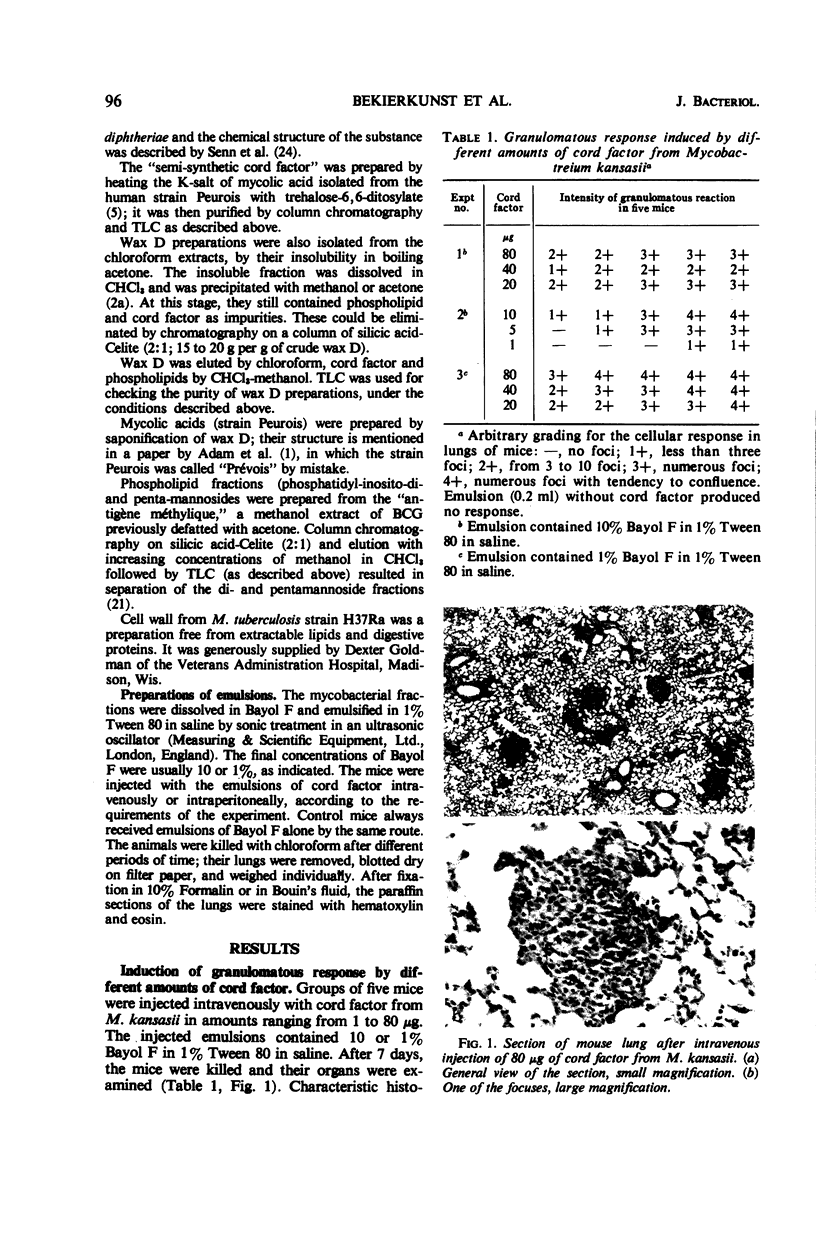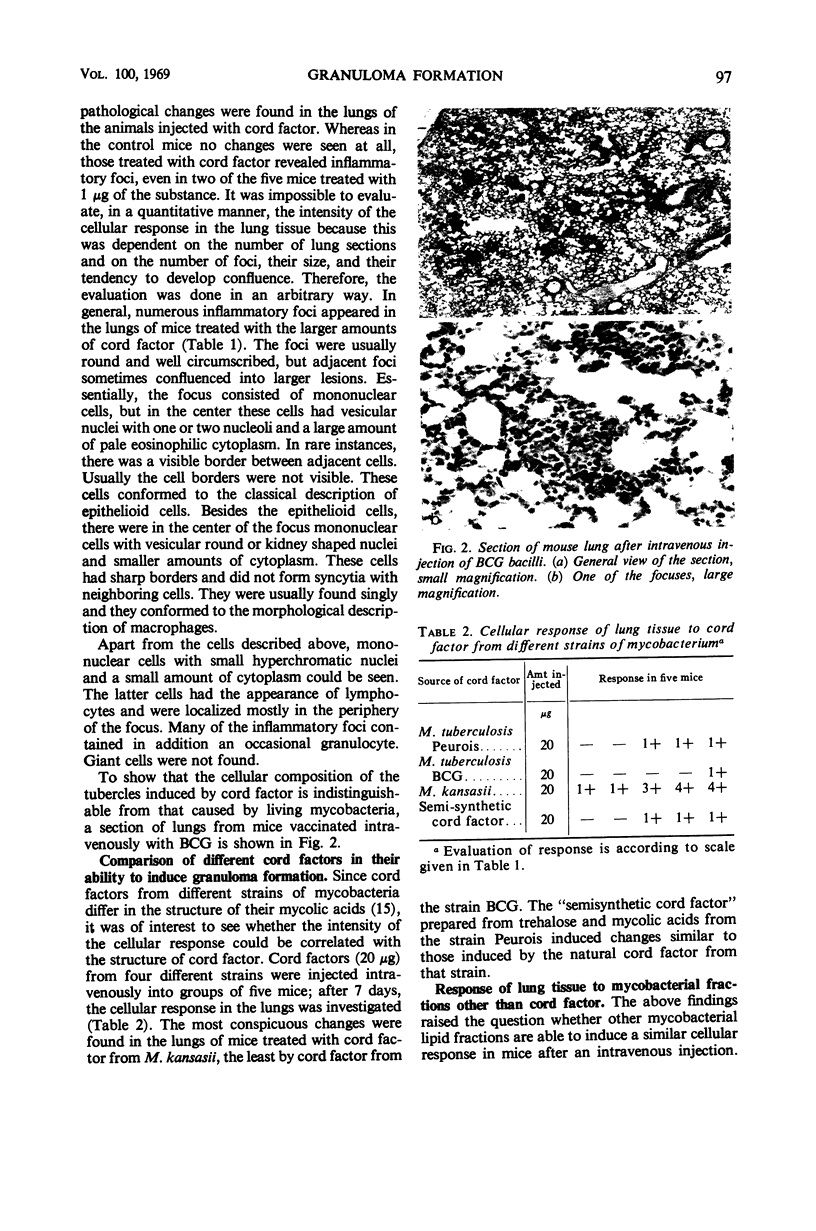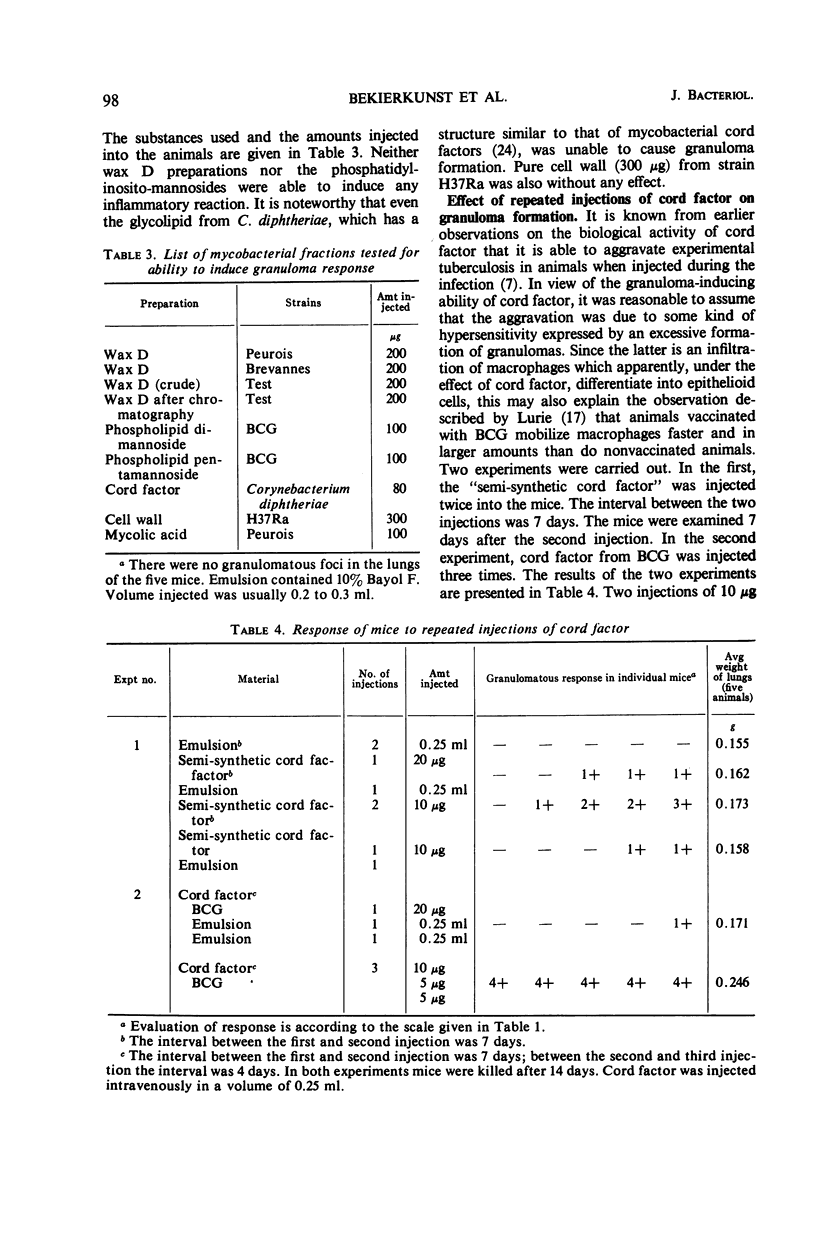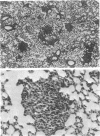Abstract
Amounts of trehalose-6,6-dimycolate as small as 1 to 5 μg can, after intravenous injection, induce in the lungs of mice formation of tubercles in which the cellular composition is indistinguishable from that in tubercles formed after an infection with living BCG bacilli. The strongest cellular response in mice was induced by cord factor from Mycobacterium kansasii; the weakest was induced by cord factor from the BCG strain of M. bovis. It was found that three intravenous injections of cord factor induced a more extensive cellular response than did one injection of the same total amount of cord factor. Mice treated intravenously with cord factor were protected against an intravenous challenge with the virulent H37Rv strain of M. tuberculosis. The cellular response in the lungs of mice to intraperitoneal injections of living BCG and cord factor was very weak compared with that after intravenous injections. Intraperitoneal vaccination of mice with cord factor did not protect the mice against a challenge with virulent tubercle bacilli. Mice vaccinated intraperitoneally with BCG were immunized although no granulomas, or very few, were present in the lungs at the time of the challenge. The significance of the cellular response induced by cord factor is discussed.
Full text
PDF







Images in this article
Selected References
These references are in PubMed. This may not be the complete list of references from this article.
- AEBI A., ASSELINEAU J., LEDERER E. Sur les lipides de la souche humaine Brevannes. de Mycobacterium tuberculosis. Bull Soc Chim Biol (Paris) 1953;35(7):661–684. [PubMed] [Google Scholar]
- ASSELINEAU J., LEDERER E. Sur la constitution du cord factor isolé d'une souche humaine de bacille tuberculeux. Biochim Biophys Acta. 1955 Jun;17(2):161–168. doi: 10.1016/0006-3002(55)90346-2. [DOI] [PubMed] [Google Scholar]
- Adam A., Senn M., Vilkas E., Lederer E. Spectrométrie de masse de glycolipides. 2. Diesters de tréhalose naturels et synthétiques. Eur J Biochem. 1967 Nov;2(4):460–468. doi: 10.1111/j.1432-1033.1967.tb00160.x. [DOI] [PubMed] [Google Scholar]
- BIOZZI G., BENACERRAF B., GRUMBACH F., HALPERN B. N., LEVADITI J., RIST N. Etude de l'activité granulopexique du système réticulo-endothélial au cours de l'infection tuberculeuse expérimentale de la souris. Ann Inst Pasteur (Paris) 1954 Sep;87(3):291–300. [PubMed] [Google Scholar]
- Barclay W. R., Anacker R., Brehmer W., Ribi E. Effects of oil-treated mycobacterial cell walls on the organs of mice. J Bacteriol. 1967 Nov;94(5):1736–1745. doi: 10.1128/jb.94.5.1736-1745.1967. [DOI] [PMC free article] [PubMed] [Google Scholar]
- Bekierkunst A. Acute granulomatous response produced in mice by trehalose-6,6-dimycolate. J Bacteriol. 1968 Oct;96(4):958–961. doi: 10.1128/jb.96.4.958-961.1968. [DOI] [PMC free article] [PubMed] [Google Scholar]
- Dannenberg A. M., Jr, Meyer O. T., Esterly J. R., Kambara T. The local nature of immunity in tuberculosis, illustrated histochemically in dermal BCG lesions. J Immunol. 1968 May;100(5):931–941. [PubMed] [Google Scholar]
- Epstein W. L. Granulomatous hypersensitivity. Prog Allergy. 1967;11:36–88. [PubMed] [Google Scholar]
- GUSEK W., KRACHT J. CYTOMORPHOLOGISCH-HISTOCHEMISCHE UND AUTORADIOGRAPHISCHE BEFUNDE AM MYKOLSAEUREGRANULOM DES MEERSCHWEINCHENS. Beitr Klin Tuberk Spezif Tuberkuloseforsch. 1964 Sep 21;129:67–88. [PubMed] [Google Scholar]
- Gerstl B., Tennant R., Pelzman O. Cellular Reactions to Mycolic Acids. Am J Pathol. 1945 Sep;21(5):1007–1019. [PMC free article] [PubMed] [Google Scholar]
- HUSSEINI H., ELBERG S. Cellular reactions to phthienoic acid and related branch ed-chain acids. Am Rev Tuberc. 1952 Jun;65(6):655–672. doi: 10.1164/art.1952.65.6.655. [DOI] [PubMed] [Google Scholar]
- MYRVIK Q. N., LEAKE E. S., OSHIMA S. A study of macrophages and epitheloid-like cells from granulomatous (BCG-induced) lungs of rabbits. J Immunol. 1962 Nov;89:745–751. [PubMed] [Google Scholar]
- Mackaness G. B. The immunology of antituberculous immunity. Am Rev Respir Dis. 1968 Mar;97(3):337–344. doi: 10.1164/arrd.1968.97.3.337. [DOI] [PubMed] [Google Scholar]
- NOLL H., BLOCH H. Studies on the chemistry of the cord factor of Mycobacterium tuberculosis. J Biol Chem. 1955 May;214(1):251–265. [PubMed] [Google Scholar]
- Pigretti M., Vilkas E., Lederer E., Bloch H. Propriétés chimiques et biologiques de fractions phosphatidiques isolées de "l'antigène méthylique" de Mycobacterium tuberculosis. Bull Soc Chim Biol (Paris) 1965;47(11):2039–2046. [PubMed] [Google Scholar]
- Senn M., Ioneda T., Pudles J., Lederer E. Spectrométrie de masse de glycolipides. I. Structure du "cord factor" de Corynebacterium diphtheriae. Eur J Biochem. 1967 May;1(3):353–356. doi: 10.1111/j.1432-1033.1967.tb00081.x. [DOI] [PubMed] [Google Scholar]
- UNGAR J., MUGGLETON P. W. The production of experimental granulomatous lesions induced by injections of fatty acids and fractions of tubercle bacilli. Am Rev Respir Dis. 1961 Nov;84(5):76–80. doi: 10.1164/arrd.1961.84.5P2.76a. [DOI] [PubMed] [Google Scholar]
- WHITE R. G., COONS A. H., CONNOLLY J. M. Studies on antibody production. IV. The role of a wax fraction of Mycobacterium tuberculosis in adjuvant emulsions on the production of antibody to egg albumin. J Exp Med. 1955 Jul 1;102(1):83–104. doi: 10.1084/jem.102.1.83. [DOI] [PMC free article] [PubMed] [Google Scholar]
- YOUMANS G. P., YOUMANS A. S. AN ACUTE PULMONARY GRANULOMATOUS RESPONSE IN MICE PRODUCED BY MYCOBACTERIAL CELLS AND ITS RELATION TO INCREASED RESISTANCE AND INCREASED SUSCEPTIBILITY TO EXPERIMENTAL TUBERCULOUS INFECTION. J Infect Dis. 1964 Apr;114:135–151. doi: 10.1093/infdis/114.2.135. [DOI] [PubMed] [Google Scholar]




